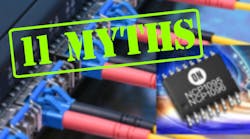At a time when wireless dominates, Ethernet may seem like yesterday’s technology, but its presence can be felt everywhere. It will even be crucial in the delivery of 5G services, thanks in part to Power over Ethernet and the latest iteration of the specification, which boosts the total power available over a single connection to 90 W.
This is a marked increase over previous versions of PoE, allowing for more sophisticated connected devices to operate without the need for an offline power supply. Despite its clear benefits, many engineers may still have misgivings about adopting the technology in their next design, so let’s take a look at some of the myths that surround PoE and set about debunking them in a rational and reasoned way.
1. PoE isn’t cost-effective.
This is probably the easiest myth to debunk, because PoE combines two essential services into a single cable. Power over Ethernet means exactly that: the same conductors are used for both power and communications, which means you really only need one cable instead of two. Plus, you don’t need to install a power outlet next to the equipment—or powered device (PD)—if one isn’t present, because all of the power is supplied by the router—or power sourcing equipment (PSE), as it’s known—over the Ethernet cable.
